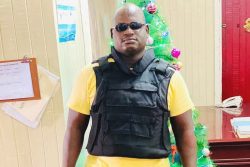Okay I know. Much of what follows below first appeared five years ago in a feature article by me and published by the Stabroek News (January 2002).
Perhaps the Mashramani hype this year is a bit low-key. Cricket World Cup? Rio Summit? The Budget? Digicel? VAT? Oh well. We are actually in the midst of the Republic Anniversary/Mashramani celebrations which really culminate with an Awards Ceremony early in March. Even though this particular year will see Mashramani-like celebratory activities continue in communities like Bartica and Mahdia ’til April.
I’ve chosen to repeat comments on local calypso because it is an art-form dear to me. I try to recall what it was in my childhood in Alberttown, Georgetown that drew me to kaiso in such a life-long addictive manner. The Trinidad calypsos on radio? Maurice Fenty, The tattooist amongst the best calypsonians at Wellington and Robb streets, near Gems make-shift studio? Or the Bill Rogers’ School Shows I attended? Or was it that as a true Guyanese/Caribbean product, I was born with the rhythm, tempo and beat of the tropical sun?
As one of my contributions to this year’s Mashramani, I repeat these views to provoke thought – much thought, I hope.
Our Calypso Art-Form
Most, if not all, masquerades, pageants, festivals and carnivals depend on music and song for their very sustenance and success. Music is the life-blood of these celebrations.
As Mashramani 2007 looms, I feel it appropriate and relevant to share a few comments on local calypso – the virtual music of Mash. This brief piece may also be considered as one personal tribute to Denis – the Mighty Intruder – Heywood (thirty-two) who sang his last note sometime ago.
Every year, around this time, connoisseurs of calypso lament either the poor standards and quality of local calypso or their now normal late start in heralding our Mashramani season. Somewhat justifiably, genuine fans and followers of the art-form point to shoddy recordings, poor under-done musical arrangements, contentious calypsonians, lack of air-play by radio stations, disc-jockeys and promoters and, of course, the usual year-long bug-bear, the scarcity of financial support for calypsonians and their bands. If all this – or even some of it – is so, how did it come about?
The latter question has some relevance especially because of Guyana’s pioneering high profile in the field in the forties and fifties. The briefest of backward glances into Guyana’s status and standing then, would reveal most significant contributions to the art-form. Especially to today’s young and uninitiated. Like the humble but powerful bottom-house “recording studio” that was Gems on Robb Street. Gems – the Guyana Entertainment and Music Services – which “recorded” Canary, Sparrow and Billy Moore, to name a sprinkling.
And this retrospective glance has neither time nor space to delve into the fact that (i) “BG”, the then British Guiana of the forties to the sixties, was always the first natural stop for the Trinidadian practitioners just before, or especially after their annual Carnival. Their kaisos and techniques had to have the Guyanese stamp of approval. All the big names came. Or that (ii) Guyanese promoter Cyril Shaw virtually made the Mighty Sparrow international by forcing him to sing for his keep even way up the Pomeroon River, before going to Trinidad to prove his worth by coming up with the now classic “Jean and Dinah”; or about (iii) how Cyril Shaw and later Vivian Lee made our own King Fighter a force to be reckoned with; later to form the Fighter/Canary team which rivalled even the Sparrow/Melody combination for standards, showmanship, picong, ribaldry and plain sweet calypso.
No, there won’t be space now to tell of the expertise and exploits of Lord Coffee, Lord Inventor, Mighty Panther, King Cobra, James Smartt, or later, El Cid all of whom the jealous Trinidadians respected – and sometimes stole away to work with them. Rather, that will be dealt with another time, because we must peek into the reason(s) for the great Guyana fall-away in Calypso.
Even though Malcolm Corrica – the Mighty Canary – was made a Minister, the general deterioration of standards from the mid-seventies say, made cultural events, expression and presentations a victim of our creeping national socio-economic demise. Calypso, among so many art-forms, had to be affected. Adding insult to that injury, our world-famous Eddy Grant was actually discouraged from establishing a state-of-the-art recording studio here since the seventies. Little Barbados has gleefully benefited from that fiasco, “orchestrated” by the topmost Guyanese political honcho of those times. And whilst all these negatives were happening, the Caribbean was hurtling forward with their music industry – carnivals, dance, recording studios, and the development of reggae, soca and other hybrids. Guyana, of course, was left in the doldrums battling instead with economic and race-based political issues.
The post mid-seventies’ economic crunch also meant that all the fabulous international road-shows and concerts featuring top international Caribbean stars, dwindled, or stopped coming here. Foreign exchange was at a premium. Local calypso singers and other entertainers thus lost a valuable window of exposure.
To its credit, amidst all this, however, Mashramani, relatively new, provided a showcase for latter-day calypsonians. With the then government’s solid support competitions produced people like El Cid, Smoker, Mighty Chief, Hitman Hemerding, Rebel, Duke et al. But sustained marketing was never done to package the calypso/soca product. The relentless professionalism of the Trinidadians, Jamaicans and Barbadians, especially, put paid to our puny efforts here. Always present too were the deadening hands of politics and the creeping autocracy stifling really creative talent.
Then, fifteen years ago, governments changed. A few minor but interestingly significant things happened to calypso. The mostly-Georgetown-based calypsonians, from 1994/1995, directed their energies to political commentary of a vigorous, Opposition-oriented anti-government type. Claiming the genre of “Social commentary”, a few pieces were reasonably-composed, competently delivered songs. However, quite a few strayed beyond, the bounds of decency, thereby raising the perennial issue of freedom of expression/literary licence versus good taste, libel and gross intrusion of privacy – as part of character-assassination. The nineties, of course saw heightened political distress in the nation, especially during and after general elections. The “Conscious” calypso singers gathered much material – from their personal or popular perspectives.
Even today calypsonians like Rebel, Sweet Kendingo, Ras Marcus, Young Bill Rogers, Tempest, Black-Hat and Stella have emerged desperately trying to keep some sort of local calypso flag flying.
Well, I won’t go on about the lack of organization among the calypsonians themselves. Nor would I emphasise the present government’s continuation of heavy sponsorship of the Mash Calypso competition when the private sector and commercial entities should really be shouldering that responsibility.
Rather, I mention the hope on the horizon for local calypso. The Youth and School Calypso competitions are discovering a few young calypso talents; the Ministry of Culture is still given to inviting Caribbean calypso technicians to share techniques with the younger Guyanese aspirants. And the Ministry is still supporting the Art-form at Mash time financially. It is willing to relinquish this responsibility to some bona fide, calypsonian or promotional grouping. Just when could this be?
Hoping these remarks do not earn me removal from the Central Mashramani Management Committee, I submit them – again to provoke active consideration.
On Judging and Judges
Notice how audiences with their pre-conceived biases and favouites, quite often, do not agree with the judges’ adjudication and decisions at Calypso
contests? Well this is likely to happen because of two main reasons: firstly, fans tend not to be objectively open-minded at competition time when they hear only the best from their personal favourite contestants; and secondly, too many in audiences are blissfully unaware of the criteria the judges follow and are often bound by.
Too often listening audiences react to their own boisterous crowd reaction and acceptance of some singer and his or her song. Judges’ rules and conditions take a far-behind third place. But I’ll return to this issue hereunder.
Tomorrow night at the Final of the Mashramani 2007 Adult Calypso Competition, Judges are obliged to look and listen for lyrics – the composition and construction of the song’s specific theme or message; melody – they look or hope for some originality and rhythmical balance. Originality!? Huh? Rendition involving diction and pronunciation and then there is presentation.
But guess what? Presentation which involves attire and showmanship attracts merely ten points! It means that the costumes worn by the contestants, the performance or stagecraft and their ability to capture the audience’s fancy and support – all that earns only ten points. So no matter how vociferous and aggressive the “crow” for a particular artiste, the judges can’t award more than ten points in all.
However at the risk of attracting the ire of the better-qualified and fair-minded competent judges, I submit this theory; I do feel that too many judges are indeed influenced by the popular crowd-response to particular singers. Those judges, I feel, then tend to award extra points in the other categories, to the “popular” contestants whose songs really won’t qualify as top places elsewhere. So you don’t agree?
Mash Mix










